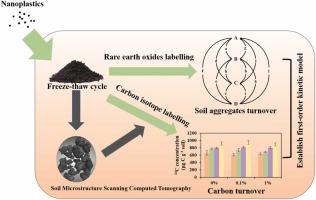冻融循环下纳米塑料改变土壤碳周转的机理
IF 11.3
1区 环境科学与生态学
Q1 ENGINEERING, ENVIRONMENTAL
引用次数: 0
摘要
纳米塑料(NPs)影响土壤碳(C)周转,但其通过改变冻融循环下土壤团聚体稳定性对这一过程的影响尚不清楚。本文采用稀土氧化物(REOs)和碳同位素(13C)标记,结合土壤微观结构扫描计算机断层扫描(sm - ct)和数据建模,研究了NPs下土壤团聚体周转率与碳周转率的关系。冻融循环下,与对照组相比,NPs处理的土壤总相孔隙度和比表面积分别增加了11.9%和30.9%。NPs对土壤团聚体稳定性有积极影响,团聚体稳定性的变化主要归因于团聚体组成的变化。冻融循环过程中,与对照组相比,0.5-1 mm团聚体中13C的分布减少了41.9%,而0.25 mm团聚体中13C的分布增加了60.8%,说明NPs将C重新定向到微团聚体中。冻融循环改善了土壤团聚体与碳周转之间的联系,而NPs增加了团聚体对冻融力的抵抗力。该研究为NPs对土壤生态系统和粮食安全的环境影响提供了新的见解。本文章由计算机程序翻译,如有差异,请以英文原文为准。

Mechanism of nanoplastics altering soil carbon turnover under freeze-thaw cycle
Nanoplastics (NPs) affect soil carbon (C) turnover, but their influence on this process through modifications in soil aggregate stability under freeze-thaw cycles remains unclear. In this study rare earth oxides (REOs) and C isotope (13C) labeling, combined with Soil Microstructure Scanning Computed Tomography (SMS-CT) and data modeling, were used to examine the relationship between soil aggregate turnover and C turnover under NPs. Compared with the control group, the total phase porosity and surface area of soil treated with NPs increased by 11.9 % and 30.9 %, respectively under freeze-thaw cycle. NPs exhibited a positive effect on the stability of soil aggregates, and the change in soil aggregate stability were attributed to shifts in aggregate composition. During the freeze-thaw cycle, the distribution of 13C in 0.5–1 mm aggregates decreased by 41.9 % compared with the control group, while it increased by 60.8 % in < 0.25 mm aggregates, indicating NPs redirected C toward microaggregates. Freeze-thaw cycles improved the connection between soil aggregates and C turnover, whereas NPs increased resistance of aggregate to freeze-thaw forces. This study provides new insights into the environmental effects of NPs on soil ecosystems and food security.
求助全文
通过发布文献求助,成功后即可免费获取论文全文。
去求助
来源期刊

Journal of Hazardous Materials
工程技术-工程:环境
CiteScore
25.40
自引率
5.90%
发文量
3059
审稿时长
58 days
期刊介绍:
The Journal of Hazardous Materials serves as a global platform for promoting cutting-edge research in the field of Environmental Science and Engineering. Our publication features a wide range of articles, including full-length research papers, review articles, and perspectives, with the aim of enhancing our understanding of the dangers and risks associated with various materials concerning public health and the environment. It is important to note that the term "environmental contaminants" refers specifically to substances that pose hazardous effects through contamination, while excluding those that do not have such impacts on the environment or human health. Moreover, we emphasize the distinction between wastes and hazardous materials in order to provide further clarity on the scope of the journal. We have a keen interest in exploring specific compounds and microbial agents that have adverse effects on the environment.
 求助内容:
求助内容: 应助结果提醒方式:
应助结果提醒方式:


